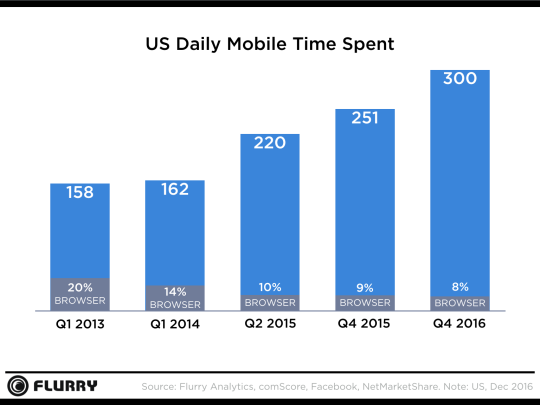TV’s Content Jumps to “FYIS” (Facebook, YouTube, Instagram and SnapChat)
In our annual State of Mobile report, we reported that total time-spent in mobile apps grew by 69% year-over-year. Since then, Snap Inc.’s stock soared on its first day of trading as the company disclosed that its users spend an average of 25 to 30 minutes a day in its mobile apps. In addition, YouTube announced users spend one billion hours a day watching videos and launched an OTT skinny bundle service. These events prompted us to dig deeper into mobile usage data, to see how these figures impact daily mobile activity and overall time spent.
U.S. Consumers Glued To Their Mobile Devices 5 Hours a Day
Flurry data shows that U.S. consumers continue to increase their time-spent on mobile devices. In fact, the average U.S. consumer spends a whopping 5 hours a day on these devices. That is a 20% increase in time-spent compared to Q4 2015. Browser share on mobile, which has been steadily declining, is now only 8%, down from 9% in Q4 2015. Apps continued to reign supreme as time spent in browsers faded; and the chat-bot revolution, which was touted in 2016 as “the app killer”, simply fizzled.

Communitainment Drives Time-Spent
A look into the data shows that 50% of time-spent is in social, messaging, media and entertainment applications. This growth has been fueled by Communitainment, or communication for the sole purpose of entertainment. Snapchat, a driver of Communitainment, especially with the fascinating growth of Snapchat, charted for the first time and now commands 2% of an average US consumer’s daily time spent. Facebook, including Instagram and Whatsapp, maintained its share of time-spent and continued to dominate the space with the addition of Facebook live and Instagram Stories. In addition, YouTube maintained its share at 3%, while independent Entertainment apps lost share, despite a 12% increase in absolute time-spent, as content, with the exception of sports and finance, migrated to YouTube, Facebook and Snapchat.

Games have seen a decline in share for a second year in a row even as money keeps pouring into the category. With users more willing to spend money on apps - partially due to frictionless payment methods like Apple Pay and Android Pay - shopping apps saw a significant growth.
TV’s Content Jumps to FYIS
In November 2014, apps put TV in their rearview mirrors, as consumers started spending more time on mobile devices than traditional television sets. At that time, most of the minutes were spent on Gaming and User Generated Content (UGC). This year, the picture has changed. In addition to UGC, premium publishers started migrating their video content to social apps, such as “FYIS”. In fact the line has completely blurred between what has traditionally been defined as premium content and UGC. In addition to this new content, “FYIS” have deployed A.I.-powered tools to constantly recommend content to consumers, creating highly personalized consumption experiences. This has led to dramatic increases in time spent in these apps.
Mobile Goes After TV’s Dollars
After taking TV’s minutes, mobile and its apps have gone after TV’s dollars. While industry analysts believed that digital would eat TV advertising dollars, more specifically, it is the cable subscriptions that mobile apps are after. With YouTube offering its first OTT skinny bundle, Hulu sneaking a peak of its planned OTT service and veterans Sling TV and DirectTV Now gaining traction, this is even more apparent. At Flurry, we believe that these offerings will further fuel mobile’s growth and will enable mobile players to siphon even more minutes from TV.
As we finished this report, the market closed and gave Snapchat an approximate 34B USD valuation, that is approximately 9% the valuation of Facebook on the same day. Snap Inc.’s share of time-spent on mobile is approximately 10% that of Facebook. This proves that the ultimate currency is not Gold, not the U.S. dollar, not the Euro, not bitcoin, nor anything we can invent. The ultimate currency is time and that time is spent on mobile.